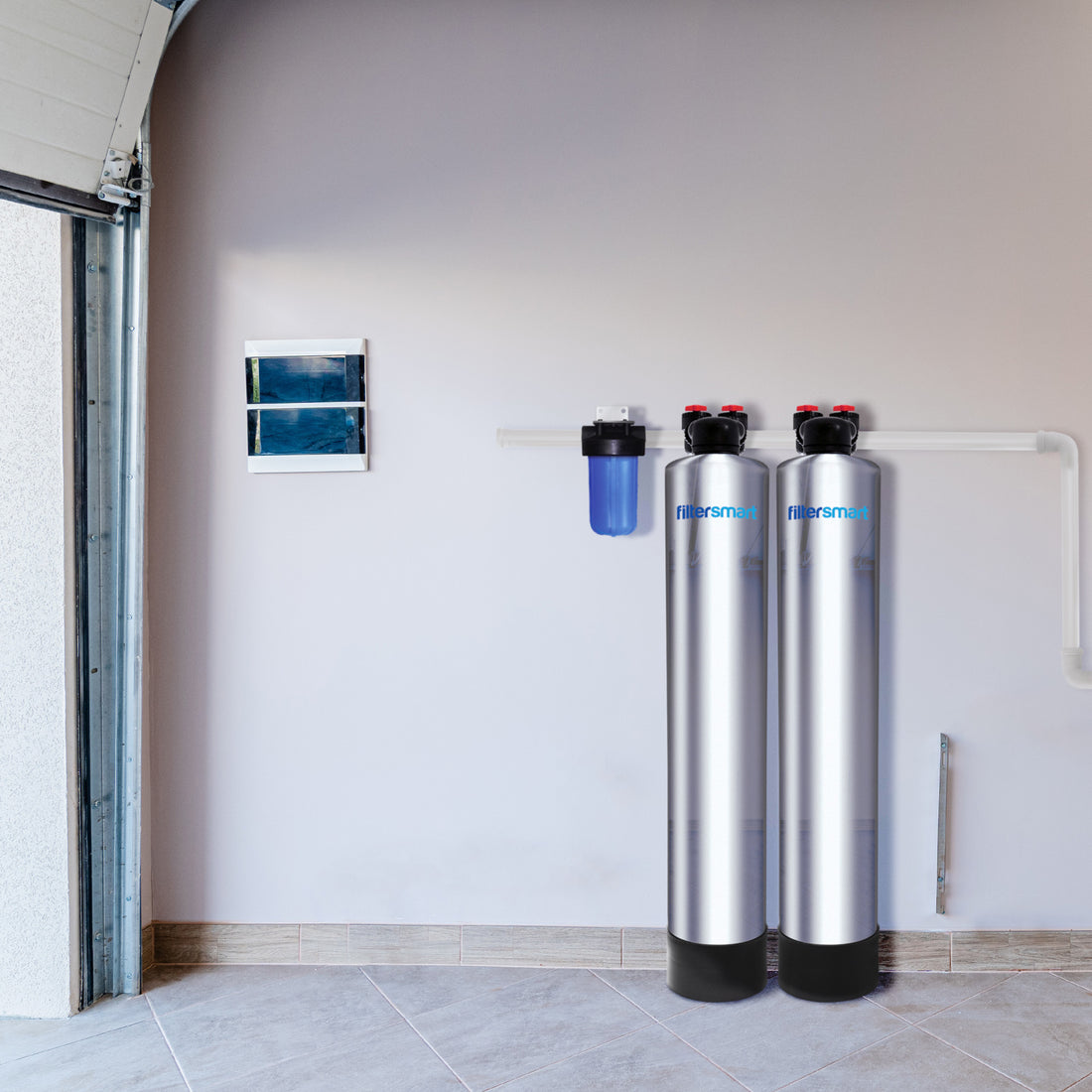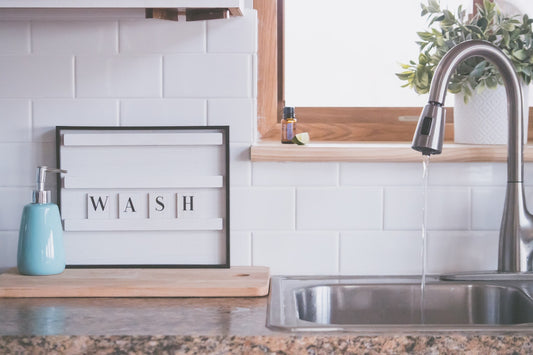Salt vs salt-free water softeners: Which is the best? Do salt-free water softeners really work? What’s the difference? Is there a difference? Will you actually end up drinking sodium if you use a salt-based water softener? And, if so, why would you pick a salt-based water softener over a salt-free water softener?
In this article, we’ll answer all of those questions and more.
When it comes to the battle of salt versus salt-free water softeners, we think there’s a clear winner for the majority of everyday applications -- but there are some advantages and disadvantages to both.
Before we go into more detail, this table shows the common benefits of salt-free water softeners/conditioners.
We’ve combed through the data and we’ll help break it down for you. FilterSmart is dedicated to helping customers make informed decisions about their water.
First, let’s start with the basics: What is a water softener?
Read More>> Price and cost of salt-based water softeners

What is a Water Softener?
Water softeners soften hard water, which is water that – for whatever reason, possibly from run-off from soil with a high mineral content or simply from poor municipal water supply management – has become tainted with high levels of magnesium and calcium. As a result, it’s hard for soap to lather, to keep sinks and other fixtures spot-free (because of the limescale), and – most importantly – to keep your energy costs down.
Limescale builds inside of costly appliances like your dishwasher, water heater, ice machine, and more. You might find that, as a result, you have to replace these appliances with alarming regularity.
So, now that you know that water softeners essentially get rid of hard water, are there any upsides to hard water?
Magnesium and Calcium: Key Minerals for a Healthy Diet
According to Medical News Today, magnesium is hugely important for the proper functioning of hundreds of enzymes in the body. It helps maintain bone health, decreases the risk of developing diabetes, decreases the risk of atherosclerosis (fatty buildup in the walls of arteries), decreases the risk of hypertension, and even relieves anxiety and eases premenstrual symptoms like bloating and cramps.
In short: magnesium is very, very good for you.
Calcium is, too. According to MedlinePlus, calcium is one of the most important minerals for the human body. It helps form proper teeth and bones, and it even staves off osteoporosis. Some of calcium’s benefits include:
-
Clotting blood
-
Squeezing and relaxing muscles
-
Keeping a normal heartbeat
Calcium is the most abundant mineral in the body. It stands to reason, then, that you should consume a lot of it. The National Institutes of Health recommends that males and females aged 19-50 have at least 1000mg worth of calcium throughout the day, as a bare minimum, to maintain proper bone health.
The NIH also states that about 43% of the US population uses calcium supplements, meaning that most people rightly feel they don’t get enough calcium in their everyday diets. Lack of calcium intake is a problem for a few age groups that the NIH researched, including boys and girls aged 9–13 years, girls aged 14–18 years, women aged 51–70 years, and both men and women older than 70 years.

The First Problem with Salt-Based Water Softeners
Salt-based water softeners aim to completely remove magnesium and calcium from your water supply. As we’ve learned, though, magnesium and calcium are important essential nutrients. Even worse, a lot of people don’t get enough calcium from their diets, making it even more essential that their water gives their bones a little boost.
This is the first problem with salt-based water softeners. The second problem, though, is that salt-based water softeners replace your water’s magnesium and calcium with sodium.
Ion Exchange
Ion exchange is a water treatment method where one or more undesirable contaminants (in this case, magnesium and calcium) are replaced with another non-objectionable substance (in this case, sodium). Ion exchange filters are built out of zeolite beads, which have sodium ions. The magnesium and calcium become trapped in the filter and then the sodium is released into your main water line.
This process also requires an electrical hookup for monthly regeneration which wastes up to 100 gallons of water per cycle depending on water hardness. This sodium is then being reintroduced back into the water supply which is harming local farmers in regions with hard water. The sodium is terrible for local farmers which I why many farming cities in southern California are banning or greatly restricting the use of salt-based water softeners.
The added cost of the water waste, electricity, and salt makes having a salt using water softener difficult to justify for the environment or the homeowner. FIlterSmart is helping thousands of homeowners make the educated switch to a more environmentally friendly and cost-efficient alternative.
Salt-Based Water Softeners Replace Contaminants with More (Worse) Contaminants
Many people don’t get enough magnesium and calcium in their diets, but plenty of people get more than enough sodium. According to heart.org, the average American eats roughly 150% more sodium than they really need. Nine out of ten Americans, in fact, eat too much sodium.
Some people might feel that, because hard water destroys their appliances and makes it nearly impossible for them to clean their clothing, they need to filter it out in some way. In doing so, they’ll replace the healthy minerals in their water with unhealthy minerals, like sodium.
The question becomes: How can you get rid of the damaging effects of hard water without getting rid of the healthy magnesium and calcium? Can you target limescale buildup independent of complete magnesium and calcium removal?

Salt-Free Softener Comparison
Salt free water softeners really condition hard water. Instead of turning hard water into soft water by replacing the magnesium and calcium with sodium, salt free water softeners (like our FS500 system), redirects scale formation by changing the crystal structures of magnesium and calcium.
Our filters keep limescale from building up by keeping magnesium and calcium suspended in water. By changing the way that the magnesium and calcium react with solid surfaces, limescale is significantly reduced or even eliminated.
Essentially, the FS500 won’t change the chemical properties of hard water, but it will get rid of almost all of the negative side effects associated with hard water, including the inability of soap to lather, the limescale on stainless steel surfaces and dishes, and – of course – the costly damage to appliances.
What’s more is that typically salt free water softeners won’t require the same level of maintenance as salt-based water softeners, which typically include a brine tank that you’ll have to regularly refill. You’ll probably also have to replace the filter (for when the brine can’t completely wash away the remaining magnesium and calcium).
Salt-free water softeners have all of the positives of salt-based water softeners with none of the negatives.
Salt-based water softeners generally do not have a carbon filter included for any filtering capacity for things like chlorine, VOC's industrial solvents and more. So salt-based water softeners basically take dirty unfiltered tap water and turn it into unfiltered dirty sodium water! That is why our combo systems is our #1 seller because it is the best of both worlds as far as filtering and treating the hardness without salt or sodium.
Salt Versus Salt-Free Water Softener: A Recap
Salt-based water softeners replace magnesium and calcium with sodium. If you work in an industrial setting, it might be necessary for you to completely remove magnesium and calcium from your commercial building’s water supply. When you’re working with appliances worth $100k+, it’s probably worth the extra sodium in the office’s water fountain.
If you’re an average Joe or Jane looking to drink healthier water and keep your kids safe, you probably shouldn’t be replacing good minerals (like magnesium and calcium) with bad minerals (like sodium).
For most everyday uses, salt free water softeners are the way to go.
Salt-free water softeners work by changing the way that calcium and magnesium react to surfaces. In so doing, salt-free water softeners eliminate the negative effects of water softening while keeping the positives.
With a salt-free water softener, you will not get the slimy slippery feeling people experience with a salt using system. Most people do not like this feeling and find that a filter and the salt free softening system is softer on their skin because of the absence of chlorine but not slippery. If you enjoy that slimy-slippery feeling then a salt using system would be the better choice
So, when it comes to salt versus salt-free water softeners, our opinion is that salt free water softeners come out on top almost every time.
Questions? Concerns? Feel free to get in touch:
Call us: 866.455.9989
Email us: sales@filtersmart.com







